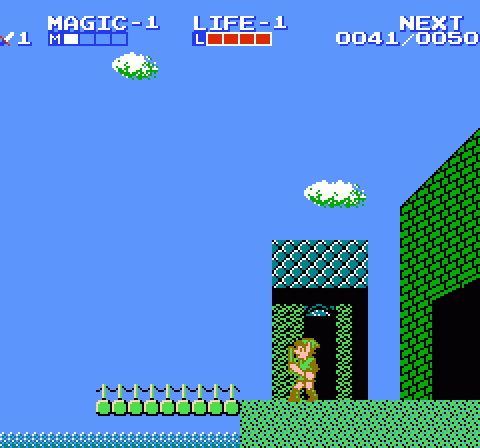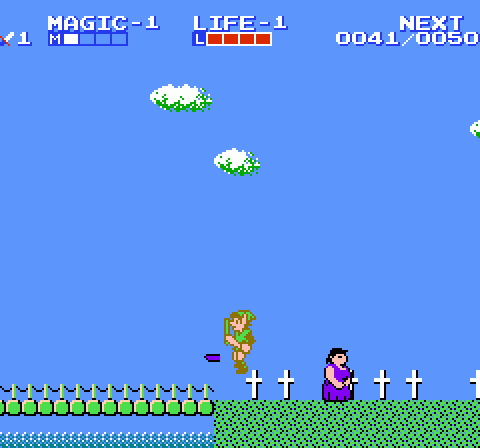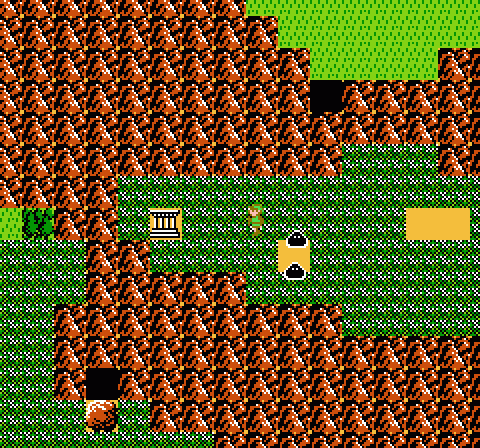Beyond the big jump that leads to the world beyond Link’s starting area, you’ll find another self-contained region housing another of the game’s palace dungeons. This area is largely submerged by swamps and overgrown by forests; the former are annoying to traverse as Link moves at half-speed on an overworld swamp tile, while random battles take place in water to his waist which likewise keeps him from moving at a normal clip. Thankfully, unlike a lot of hateful 8-bit games, swamp tiles aren’t innately poisonous or anything, so you can proceed directly to the palace if you want.
However, you don’t have to. The dungeon contains, as with Parapa Palace before it, both an essential tool for game progression and the requisite crystal for unlocking the Great Palace, but you don’t need either of these to advance to the next area of business to the south. Instead, the key to forward movement lies in the Water Town of Saria, where a retracting bridge connects the town on the north shore to the south side of the river that cuts through it. The guard controlling the bridge refuses to let Link cross as he’s not a resident of the town.

Here we have opaque 8-bit design in action for the first time in Zelda II, and as such the first real sticking point for anyone without a guide. The guard’s statement might lead one to surmise that they need help from someone in town to unlock the bridge, but no one in Saria seems to offer much help. You have the standard ladies patrolling their front doorsteps — the pretty lady who refills Link’s health, the old crone who restores his magic, and the side-quest lady who in this case complains that her mirror is missing — but no one else has anything of value to say.
On the contrary, the one other piece of unique information in Saria comes from the weaselly looking dude at the entrance, who warns that the eyes of Ganon are everywhere. Turns out this isn’t just some kind of Lord of the Rings reference; most (if not all) the wandering NPCs in Saria transform into bats and attack Link if you talk to them.

It’s a pretty clever way to convey a sense of danger to the player — the world beyond Zelda’s eternal slumber is hostile and dominated by Ganon’s influence from beyond the grave! — but the designers erred in introducing this element at the same time as giving players a misleading clue about needing help from someone in town. If you assume (sensibly enough) that you’re meant to get help from a Sarian, you’ll take plenty of abuse from transformed bats. You could even fall into the trap of thinking these bats somehow hold the key to extending the bridge.
As it turns out, none of that is the case. Rather, the trick to getting further into the game is simply to talk to a guy named Bagu who very decidedly does not live in Saria. He resides in the woods to the north, and mercifully doesn’t have any sort of fetch quest attached. You talk to him, he gives you a note, you take the note to the river man, you advance to the south.

Unfortunately, none of this is hinted at in game. No one gives any indication that you should be looking for Bagu, and he lives in a seemingly random patch of forest with no real indication of where to look. Well, that’s not completely true; the row of tiles one space south of Bagu includes several fixed encounter spaces where you are thrown into battle against some low-end monsters with a background of tree stumps rather than the usual forest setting. Presumably this is meant to denote the proximity of a lumberjack, but this implication doesn’t really click until after you meet Bagu; instead, it just seems like some inexplicable mystery in which the clearings are important in and of themselves.
Points to the game for trying to give clues and tell stories within the boundaries of normal play — a vital and valuable trait! — but in practice it proves too abstract to work the way it was intended here. As such, players won’t progress beyond Saria until they happen to stumble onto Bagu’s space… and the high-end encounters in the forests here are so annoying that most players will avoid wandering through the forest altogether. Oops. Good thing we had Nintendo Power, huh?

The other major feature of this area — the Swamp Palace — is decidedly less irritating. However, it is shockingly large and quite difficult. Zelda II doesn’t waste any time building up to challenging dungeons, and Swamp Palace makes the already sizable Parapa Palace look like a tarpaper shack. Enemy encounters are considerably more daunting, and you need to do a fair amount of backtracking to find the keys required to unlock the way forward. Most of the palace’s bulk appears behind a locked door to the west of the entrance on the top level, but you need to descend into the eastern portions of the maze to find the key forward.
Players face several threatening new enemies here. The gold Ironknuckles return along with their far more aggressive (and defensive) red counterparts. Red Ironknuckles prove to be some of the most frustrating enemies in all Zelda II thanks to their almost prescient ability to block your attacks while stabbing rapidly and quite independently of their shield, as well as doing their best to body-check you.
Still, the knights aren’t nearly as horrifying as the worst enemies in this dungeon: The severed horse heads that fly in a sine wave pattern like Castlevania‘s Medusa Heads. The nasty trick to the horse heads, however, is that they don’t simply slam you for a penalty to your health — they also drain experience points. Killing each head is worth 20 EXP, but if you let one touch you, you’ll lose 10 EXP. That’s a low blow straight out of tabletop RPGs, and it makes these guys absolutely terrifying — at least until you max your levels and experience no longer matters. But here, where you’re plinking most foes for 2-10 EXP and you’re starting to reach skill levels that require thousands of EXP for an upgrade, this sort of numeric drain is precisely what you don’t need to deal with.

Other notable enemies include the skull-emblazoned Bubbles, which appear in thicker numbers than in Parapa Palace and drain magic in addition to health, and upgraded Stalfoses which have added a leaping downward attack to their repertoire (a hint of things to come for the player). The Bubbles (as noted by Tomm Hulett in the comments) are worth a hefty amount of EXP and are pretty easy to kill despite their huge hit point totals since you can stun-lock them with basic stabs. On the down side, this also dungeon introduces wall-mounted statues that fire streams of projectiles at you. These things appeared in Zelda as well, but the form they take here is really frustrating since the stream is uninterrupted and getting past it without taking a hit or two proves to be incredibly difficult. Their bullets do little damage, but it’s cheap nevertheless.
The boss looks fairly different from the guy in Parapa, but he’s essentially the same. You jump and stab his head and try not to absorb his counter-blows. The one thing livening up this fight is that the first two times you stab him, his head goes flying off and floats at the top of the room firing projectiles. Yes, you knock his head off twice before you reveal his true face. I guess you can’t fault him for prudence, wearing two helmets into combat.
Meanwhile, the item for this dungeon — the Glove — allows you to smash certain types of block with your sword. You use this as a key to access the depths of the palace, but it doesn’t really play much of a role in the game for a while and doesn’t truly shine until you learn some advanced sword techniques. But still, it’s always awesome to beat up the scenery.
As someone who started a replay of this game a few weeks ago and is currently swearing lustily at the Thunderbird in the Great Palace, this entry begins to touch on a subject in Zelda II that I hope warrants discussion, namely: How is anyone reasonably supposed to conquer this game without the aid of a walkthrough or spoilers, be it issues of Nintendo Power, various available FAQs, or a playground of kids exploring the game together?
Even played with a walkthrough, this game is a marvel of “screw-you” difficulty. Played without a walkthrough, I honestly struggle to envision how anyone would figure out how to find magic spells and upgrades hidden down house chimneys, stumble upon little kids lost in mazes, hazard upon New Katsuo, feel your way through false walls in palaces, or locate the multiple Heart and Magic Containers randomly scattered throughout the overworld that are critical toward giving you a fighting chance against some of the tougher bosses like Gooma or the Thunderbird.
Is it a question of valuable information lost in the game’s translation from Japanese to English? Or was the game’s intention to be this opaque? NES-era combat difficulty aside, it sometimes feels as if the game’s design itself is actively trying to frustrate your attempt to play it.
Totally agreed. Later in this series I’ll be writing about the point at which I got stuck for a month.
I’ve been enjoying your blog for a while now. I’m a big fan of the Zelda series of games and this is bringing back some cool memories. I really like what’s going on here and I can’t wait to see more of this. Keep it up!
You actually do get a hint about Bagu’s location in Saria. One of the houses has a purple slime that is sleeping when you talk to it. Talk to it at least 4 times to wake it up and it will tell you “master is in woods n of river”.
Oh, my failing here was in not repeating unproductive actions multiple times. Silly me!
I always assumed that the ladies that take you in to “refill your health” were hookers. Then again, I might have just been a really perverted kid.
Ichbinmiah, I recall Miyamoto saying that he intended the Zelda games to be just opaque enough to make kids talk to each other at school about where they get stuck, but he may not have intended them to be as hard as Zelda 2.
Oh man, you know what I did for that sleeping slime? I stabbed the wall next to it about 100 times because I thought its sound was annoying enough to wake it up. I’d talk to it every few dozen stabs, so eventually it would wake up, but I didn’t know simply talking four times would do the trick. Great job conveying the idea, Nintendo!
Maybe it’s just that I’ve played the game so many times now, but Ironknuckles aren’t nearly as intimidating anymore. The key to them is the jumping slash. Do that with precision, and they will pretty much never touch you. It does require a bit of space to operate, however.
Now the stupid Blue ones… sheesh. Those guys are still brutal, and I’m sure you’ll have loads of fun talking about those!
ichbinmiah, do you want any hints as regarding Thunderbird? It’s actually pretty easy if you use the right spells. Discovering what those _are_, of course, is another matter, and lines itself up with your statement on the game.
I agree with Sarge, the Ironknuckles are less daunting as soon as you figure out jumping and slashing, but it’s a good idea to learn to use your shield effectively for the later palaces, which is something I never did with this game as a kid because I wasn’t patient enough to know when to stop slashing and actually parry things.
Like with Simon’s Quest, I find myself loving the outside portions of the game and disliking the interiors. Most palaces require some backtracking due to key placement and depending on which fork you take, sometimes you have to backtrack more than once. This wouldn’t be so annoying if not for the endlessly respawning enemies like the floating heads, jumping tinsuits, and bouncing bubbles (who come back once you leave a screen I think). I’m not sure what annoys me about these enemies more - having to kill them constantly or knowing that they’re there just to fill empty space.
Sarge: The Fokkas in the Great Palace are even worse. Ironknuckles don’t scare me, but those guys?
Regarding the purple Bit/Bot in the town, it’s something to keep in mind for later, as that trick will come into play again. That said, encountering it is a rather unusual circumstance (much like the empty house with the mirror, chimneys on houses, or the town with the fountain), so you know there must be some trick to it. If something seems out of place, there’s usually a reason.
One thing I found particularly interesting is the townsfolk who turn into Aches (bats): Some do it right away, others if you speak to them repeatedly. Similarly, some can be killed with little effort, and others take an IMMENSE number of hits to kill- more than some (or all) bosses!
I always found the concept of experience points being taken away to be amusing, if nothing else. What is that implying? Loss of memory? Is Link getting a concussion each time he’s hit by one of these things?
One question about the fight with the boss, Helmethead: Did you get the downward-thrust attack first? I thought it was essential to beating him, but thinking back, I might have heard that he just has a really small hit box in his last form.
LBD “Nytetrayn”: Yeah, now those dudes are _evil_. Fokkas, indeed. Most of my time with them consists of getting past and RUN RUN RUN CRAP HE’S GETTING CLOSE RUN RUN RUN!
Honestly, most of the spots, if you’re careful, you can situate yourself up high and take them out when they jump into your sword. But there are a few points at which it’s just not an option. Either take them out, a daunting task, or get clear.
…which is also a daunting task.
I for one always felt that the obliqueness of these early NES games added such a rich real life dimension to my gaming experience that I have a tough time separating them from the nostalgia of youth. Unlike other games like Mega Man where I simply associate playing the game and hearing the music with a simpler time, games like Zelda II were played; secrets cracked; items discovered; enemy weaknesses laid bare through my social interactions as a youth. Part of any adventure involves uncovering the covered. As a kid, a sizeable portion of my time was spent in meetings with fellow adventurers on the playground. We would compare stories, notes and even sometimes maps. This collective journey, in my mind, WAS gaming, it WAS Zelda. I can’t dissociate the two. This, I suppose judging from earlier comments, is what Miyamoto intended. That lived experience was my guide- and now, years later, the very idea of playing through Zelda or Zelda II without such aids is unfathomable and a little melancholic.
I’m pretty much agreeing with what Nate said - by the time I got my hands on a NES console and a copy of The Legend of Zelda, most of of the stuff needed to navigate LoZ critical path had already been documented in Nintendo Power, whereas Zelda II was probably the first arcane NES game I had access to where I was stuck figuring out the game’s mysteries before most of them were unraveled by Nintendo Power (or the kids at school had even more free time to wander Hyrule than I did).
That’s not to excuse Zelda II’s often-questionable quest design, but it’s funny how it being the first sprawling NES game I had to figure out largely on my own has colored my memories about the game, so much so that it remains a sentimental favorite even if it’s the most unloved game in the series for most anyone with half a brain (or the luck to’ve grown up with of Zelda II’s more refined progeny).